Introduction
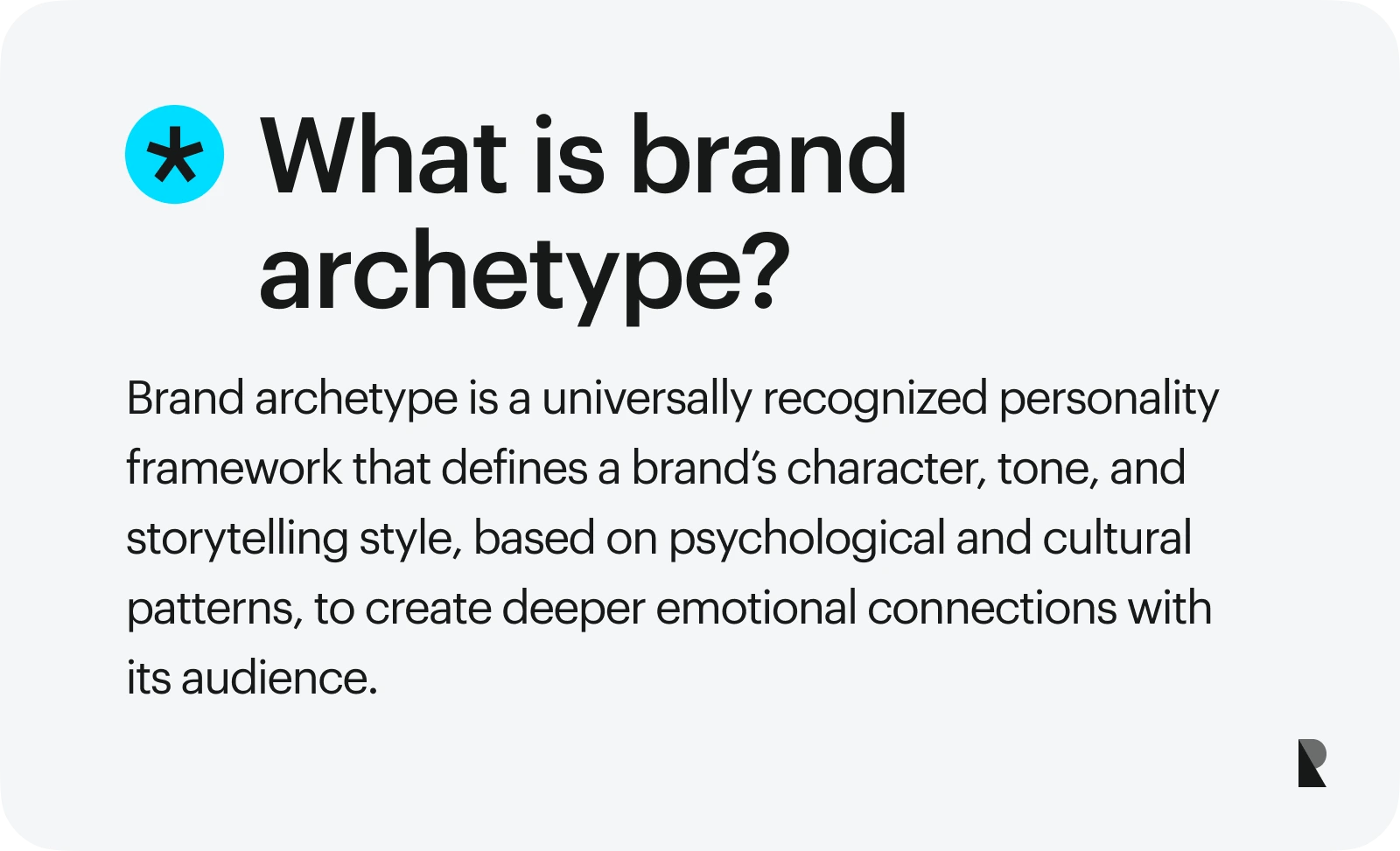
Do you know that the majority of our purchasing decisions occur on a subconscious level? According to studies, we often allow our emotions and spur-of-the-moment to call the shots. We easily fall for products, which once produced a social bonding experience, without giving it extra thought. We also prefer personified brands over others because they remind us of humans to whom we can easily connect and relate.
These phenomena seem to erect huge obstacles on a company's path to successful branding and growth. Yet, as it turns out, businesses can take advantage of that by capitalizing on brand archetypes.
Brand archetypes provide companies with a unique framework based on human psychology. They reveal the full beauty of a company's unique personality, help it stay authentic across marketing and advertising efforts, and, most importantly, connect with its audience in a deep, meaningful, and human-like way.
Consider this concept closely to see how your brand archetype can help you grow into a successful venture.
What Is a Brand Archetype?
A brand archetype is an integral method of presenting a company to the world, market, and customers. It encompasses value, mission, symbology, ideology, and key message under a unique personality and humanizes how a company interacts with people.
There are 12 known categories: The Outlaw, Creator, Magician, Hero, Lover, Jester, Everyman, Caregiver, Ruler, Innocent, Sage, and Explorer.
Brand archetype humanizes the connection and interaction with the target audience.
It provides a solid framework for staying consistent, choosing the right tone of voice, making the company recognizable, and, most importantly, relating to people who share those values, building a strong emotional bond.
Emergence of Archetypes
According to Wikipedia, the origins of the archetypal hypothesis date back to the ancient Greek philosopher Plato, who believed that each soul had "eidos." Eidos are pure mental forms that embody a thing's fundamental characteristics.
Later, the famous Swiss psychiatrist Carl Jung suggested that "eidos" represent metaphysical ideas that people or real things have. This model image is innate and hereditary. It is the fundamental driving force that influences a person's behavior, desires, values, motivations, and even needs on a subconscious level.
In 1940, he developed a set of four major personality archetypes: anima, the self, the shadow, and the persona. Afterward, he added others, including the wise old man, the child, the mother, and the maiden.
As it turned out, his work has become useful in brand development. Brands can be considered as things whose image and behavior are formed from identity features and influenced by internal and external factors. Every company has so-to-say personality traits that humanize and personify its image and behavior.
This theory was first formulated by a Viennese psychologist, Dr. Ernest Dichter. He successfully applied these psychological constructs to marketing and proved that they promoted easier discovery and stronger loyalty for companies.
Over time, it has become obvious that defining the right archetype for the company and staying within it during all strategic decisions help to create a consistent brand image and appeal more accurately to a given desire of a specific personality.
Why Is It Important to Use Archetypes?
Archetypes help create an immediate familiarity. They allow users to relate to an event, character, or company and form an emotional bond without much effort.
This process happens on a subconscious level. It is scientifically proven that we can recognize archetypes without any additional knowledge, skills, or explanations. Our comprehension and understanding of personality are based on instincts and life experience, expending relatively little mental energy.
The importance of defining and using the right archetypes in business mostly lies in what it can do for you. For instance, the right archetype hits deep emotional triggers and bonds closely with prospects. Speaking directly to the person's innermost manipulates their decision-making process.
On the other hand, understanding a company's archetype offers real insights into how others see the brand. Brand design company may use this information to improve how a client is perceived. It helps entrepreneurs employ strategies and campaigns to make the best first impression possible and influence an overall impact.
These key features of archetypes open golden opportunities for companies. Working for every niche, product, and market segment, they provide businesses with a much-needed framework for developing and marketing successfully.
Twelve Brand Archetypes
There are 12 archetypes: Creator, Explorer, Sage, Caregiver, Everyman, Innocent, Jester, Magician, Ruler, Hero, Rebel, and Lover. But which one is you? Let's consider them closely.
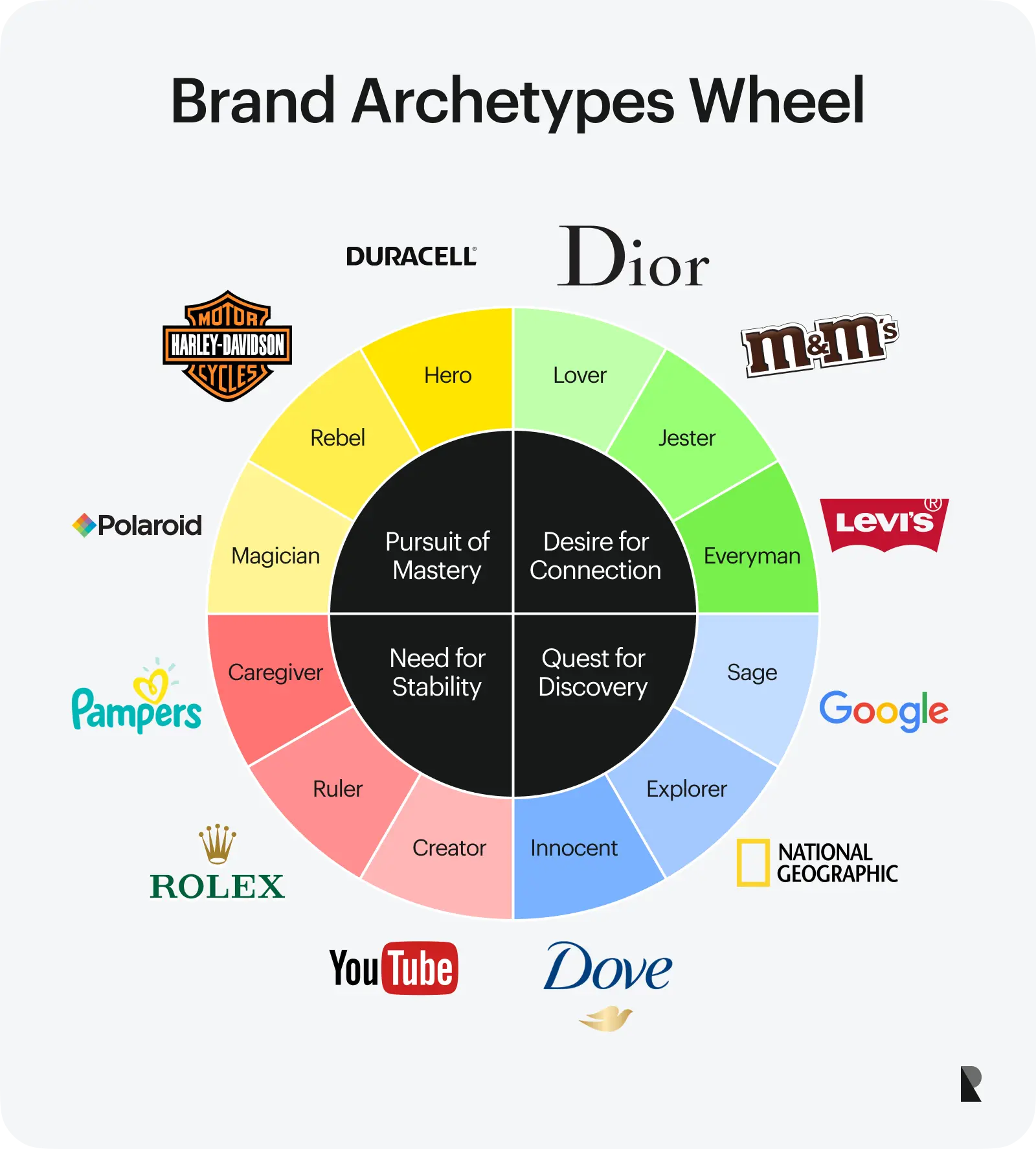
Brand archetypes wheel
1. Creator
This basic brand archetype centers around creativity and artistry. It is not afraid to show its true self, run its imagination wild, and express its personality and charisma through the most daring means. It is an innovator who first comes up with an idea, brings to life a concept, and tests the limits of creativity and design.
The key traits of the Creator are Originality, Creativity, Imagination, Self-Expression, and Unique Vision.
This type values design and uses its endless imagination to create products and methods to communicate with the audience.
Brands like Lego and Apple fall into this category.
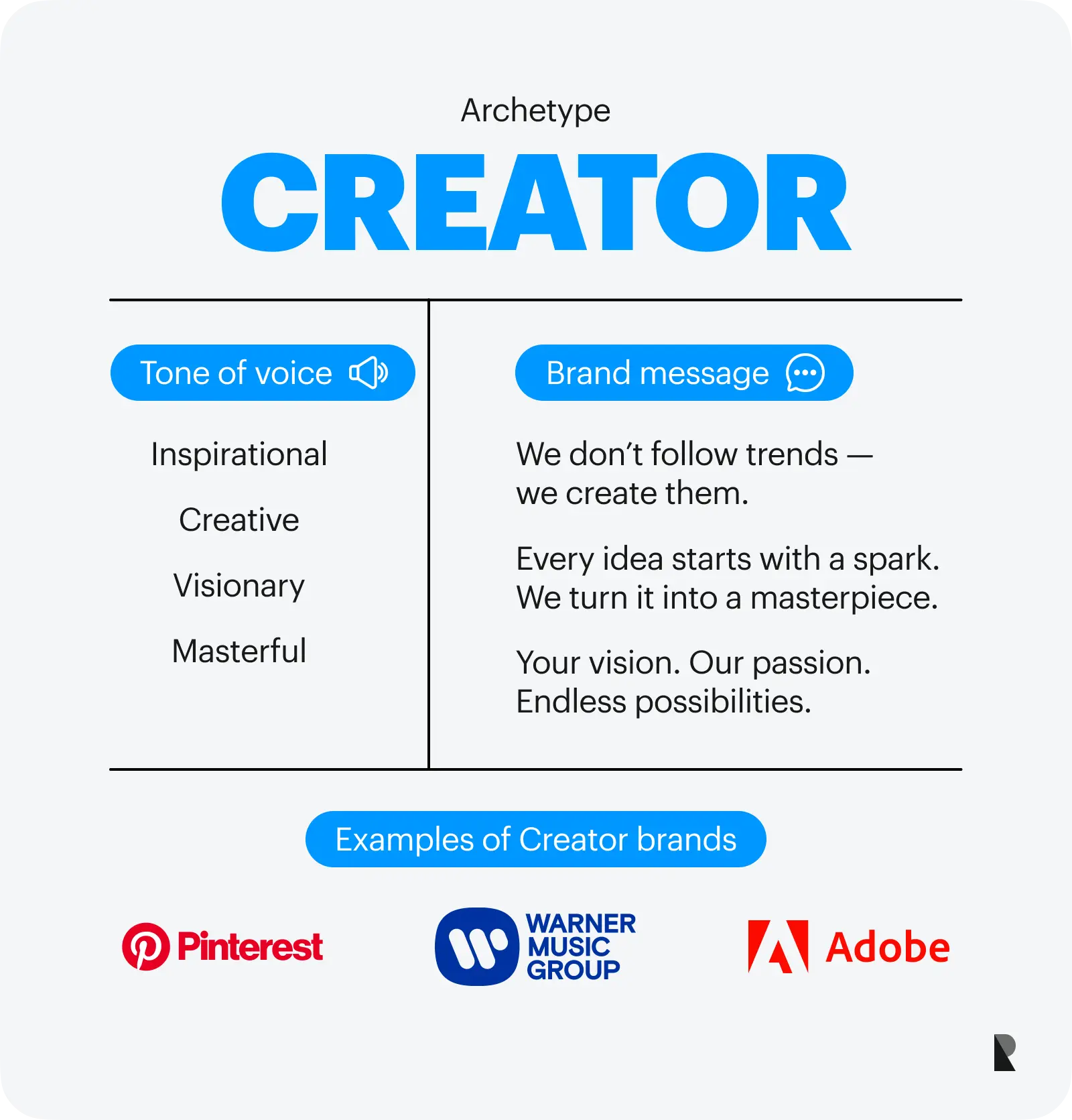
The Creator brand archetype
2. Sage
The Sage archetype is the wisest of all. Coming from the Latin word "senex," which means old, it represents the personality that accumulates knowledge, skills, and wisdom. Its rich experience and pursuit of understanding the world give others all they need to improve their life. Think of them as thoughtful leaders and mentors who have mastered certain niches.
The key traits of the Sage are Wisdom, Expertise, Knowledge, Skills, Experience, and Influence.
This type passes on their knowledge and experience and encourages others to solve their problems through their products or services.
The most notable examples are Harvard and the Discovery Channel.
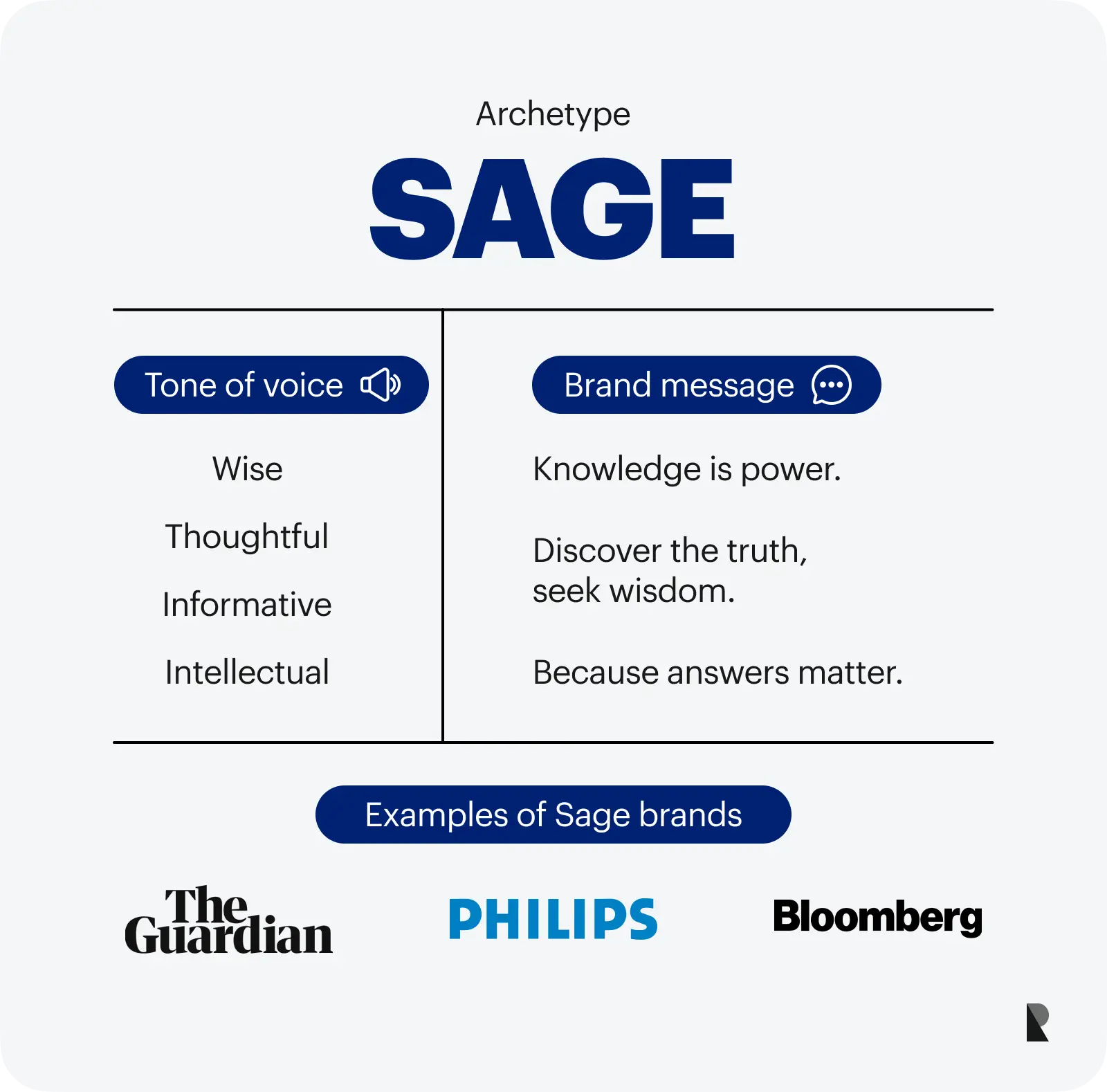
The Sage brand archetype
3. Caregiver
A caregiver is a compassionate and selfless person who cares for the people around them. It has an innate desire to protect and help others. It is active and preventive in its actions and prioritizes those in need.
The key traits of the Caregiver are Caring, Compassion, Selflessness, and Protection.
This type takes a warm, thoughtful, and motherly approach to customer needs and problems. It puts them first and creates a safe space for everyone.
The most notable examples are Pampers and Unicef.
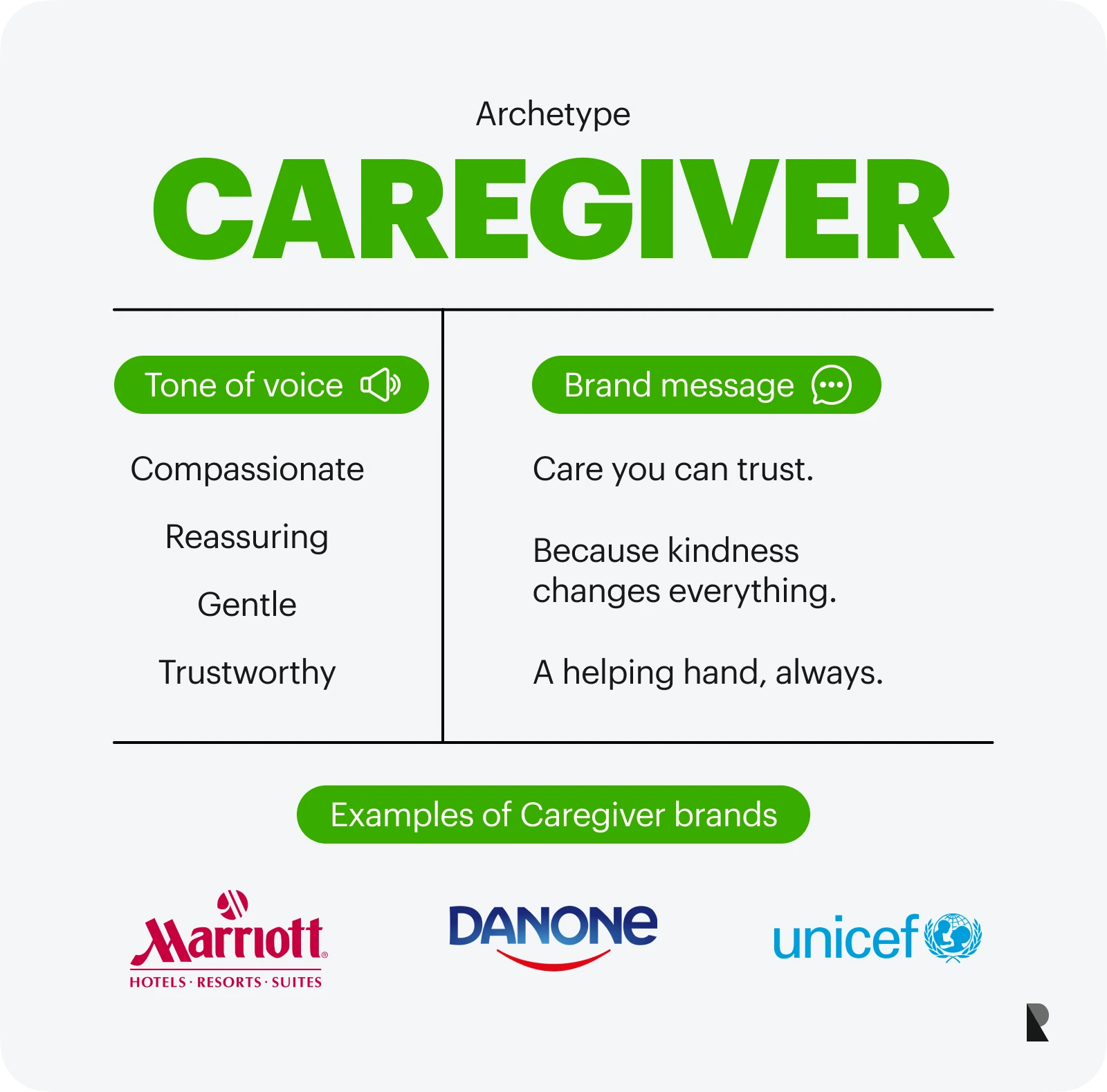
The Caregiver brand archetype
4. Innocent
The innocent archetype has an optimistic, upbeat, joyful personality eager to share happiness. It is honest, pure, candid, and genuine. It avoids situations that may harm or injure people and creates a safe and, at the same time, positive space.
This type values simplicity and honesty in solutions and avoids negative or guilt-based communication. It sticks mostly to all-natural approaches and promotes transparency in relationships.
The key traits of the Innocent are Positivity, Optimism, Honesty, Loyalty, and Simplicity.
The most notable examples are Volkswagen and Dove.
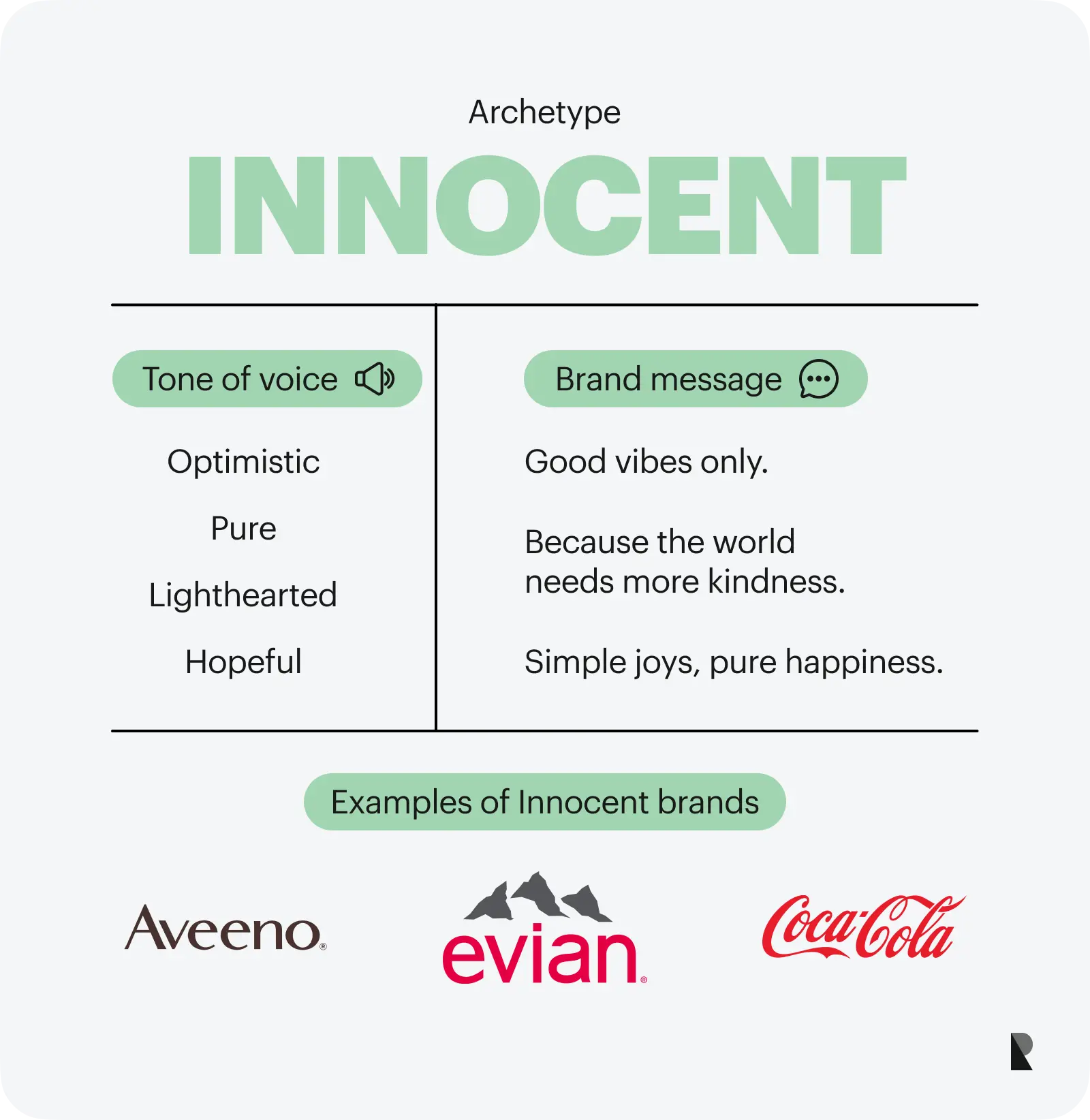
The Innocent brand archetype
5. Jester
The Jester archetype shares some features with the Innocent archetype. It also wants to bring happiness and help you create a positive atmosphere. However, it has a different approach. It uses humor, wit, and laughter to encourage others to enjoy every moment of their lives. It falls for various tricks, from mocking conventions to making wittily humorous remarks.
This type sees the good in every situation and empowers others to do the same through a positive attitude. It associates itself with fun, laughter, and quality time.
The key traits of the Jester are Humor, Positive, Wit, Playfulness, and Togetherness.
The most notable examples are Skittles and Nickelodeon.
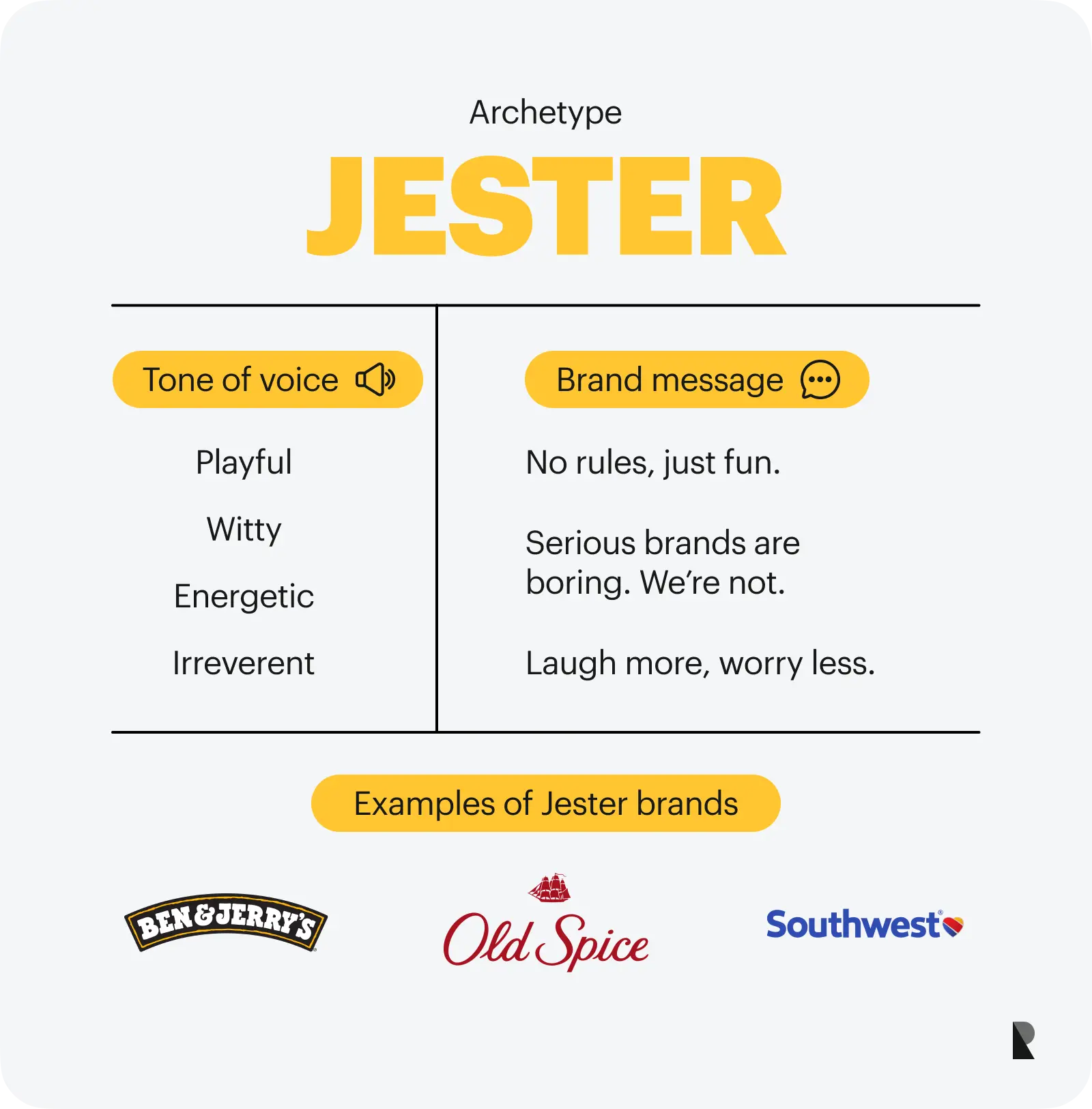
The Jester brand archetype
6. Magician
Magician like Creator is a visionary with a lavish imagination and a wealth of creativity. It takes an approach even further by implementing everything it can, including mystical ways, to bring any idea to life, change the world, and make dreams come true. Charismatic, clever, and a bit crazy, it encourages people to undergo transformative journeys and make the impossible possible.
This type focuses on customer transformations and providing a one-of-a-kind experience that leaves an unforgettable, long-lasting impression.
The key traits of the Magician are Imagination, Transformation, Creativity, and Insight.
The most notable examples are Walt Disney and Maybelline.
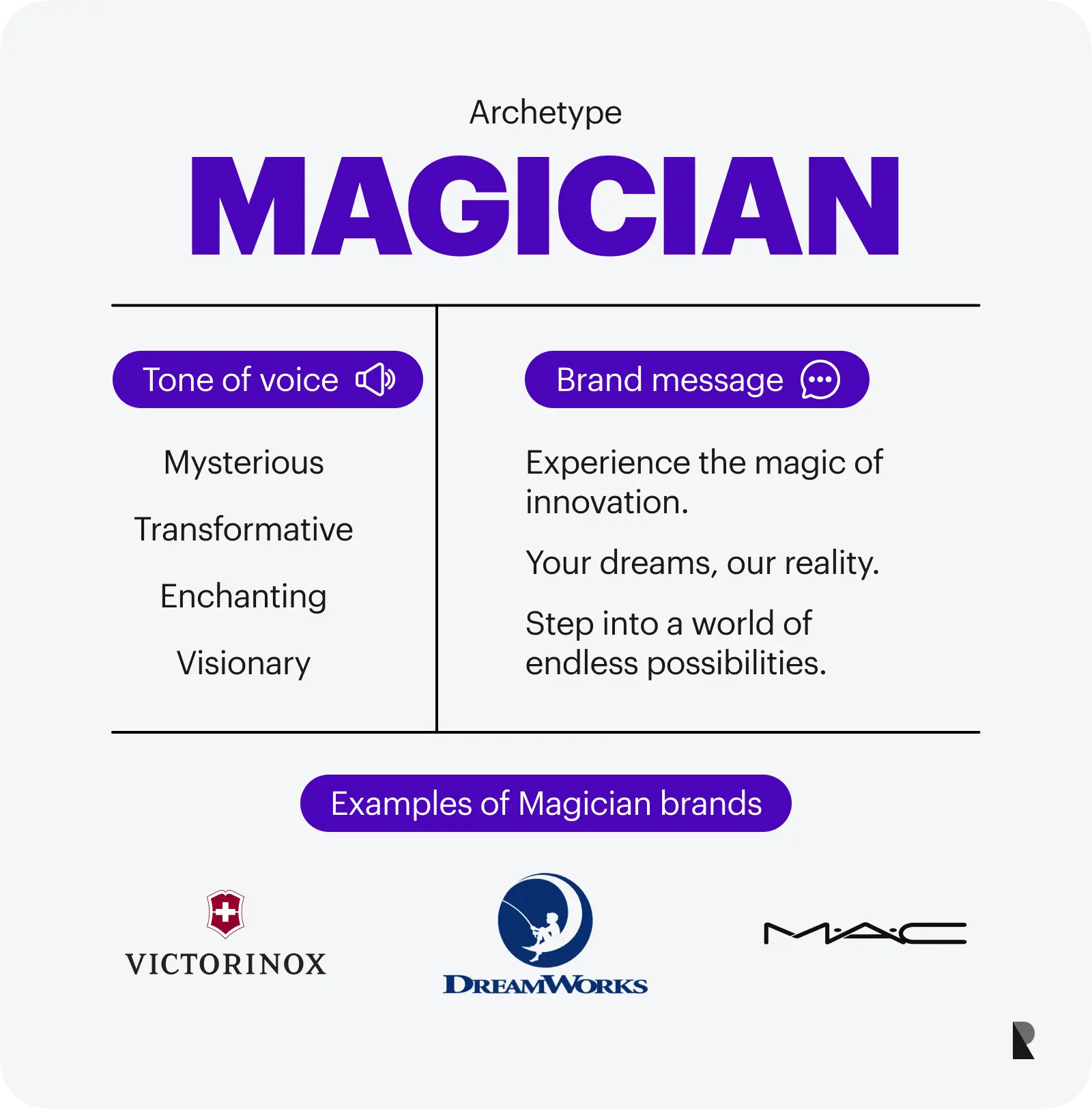
The Magician brand archetype
7. Ruler
Perhaps the Ruler archetype is one of the most dominant of all. With its strong personality, exceptional confidence, and cravings for leadership, it can be quite ruthless in achieving its goal. It is all about total control and rules that must be obeyed. It has an undeniable expertise, which it boldly applies to achieve success or defend its position.
This type seeks any way to reaffirm their sense of power and get the situation under control. Its products allow customers to maximize their superiority and feeling of exclusivity.
The key traits of the Ruler are Confidence, Trustworthiness, Leadership, Dominance, and Control.
The most notable examples are Rolls-Royce and Rolex.
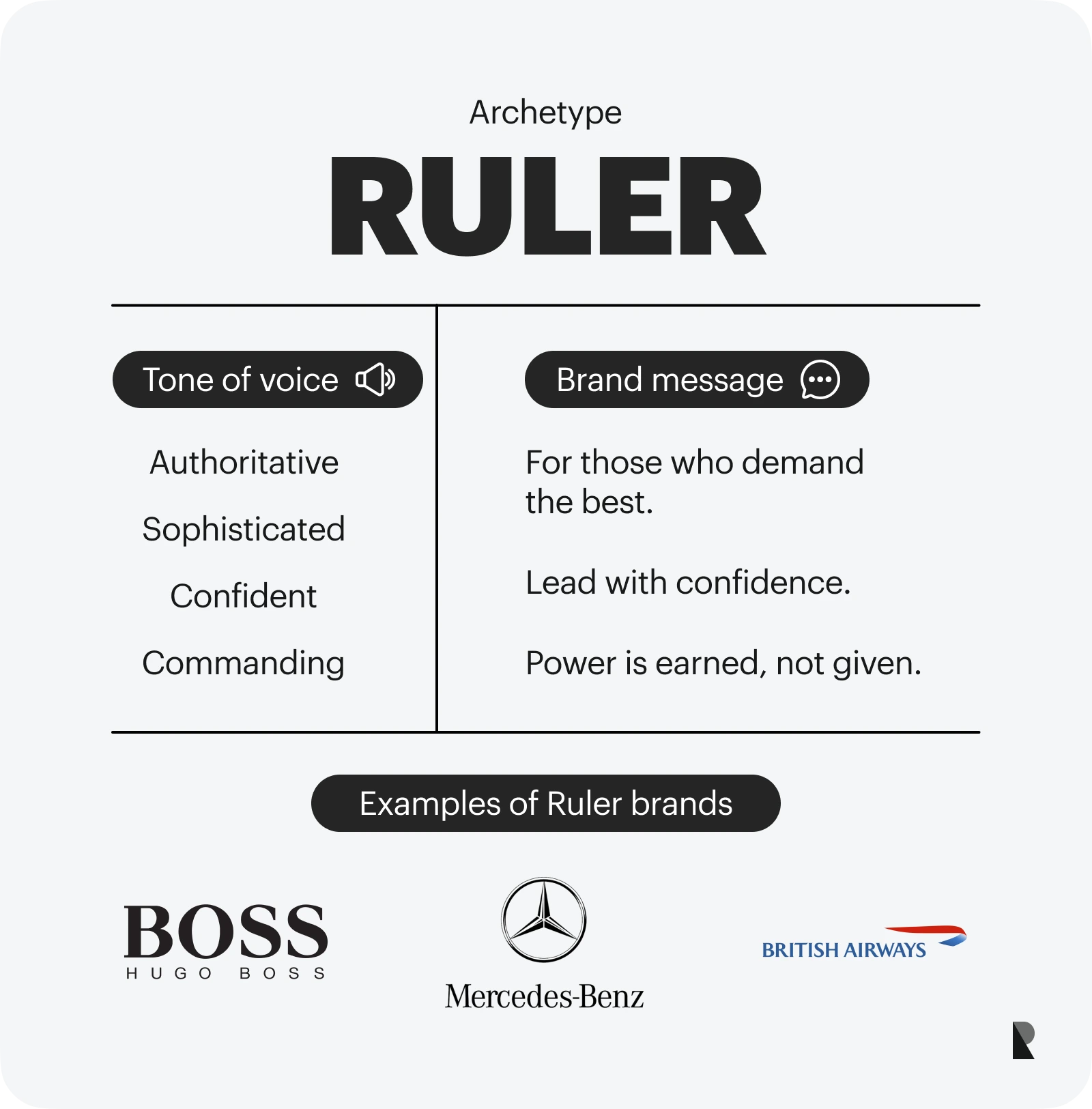
The Ruler brand archetype
8. Hero
Hero archetypes always demonstrate commitment to morals and do everything they can to overcome injustice. Their ideology of bravery, courage, and determination for a better good makes a difference in this world and encourages others to personal transformations. They are hard workers who put in much effort to meet challenges.
This brand archetype connects with customers through inspiring messaging. It taps their ambitions and pushes them to overcome all obstacles in their path to success.
The key traits of the Hero are Bravery, Capability, Inspiration, and Courage.
The most notable examples are Nike and The Royal Marines.
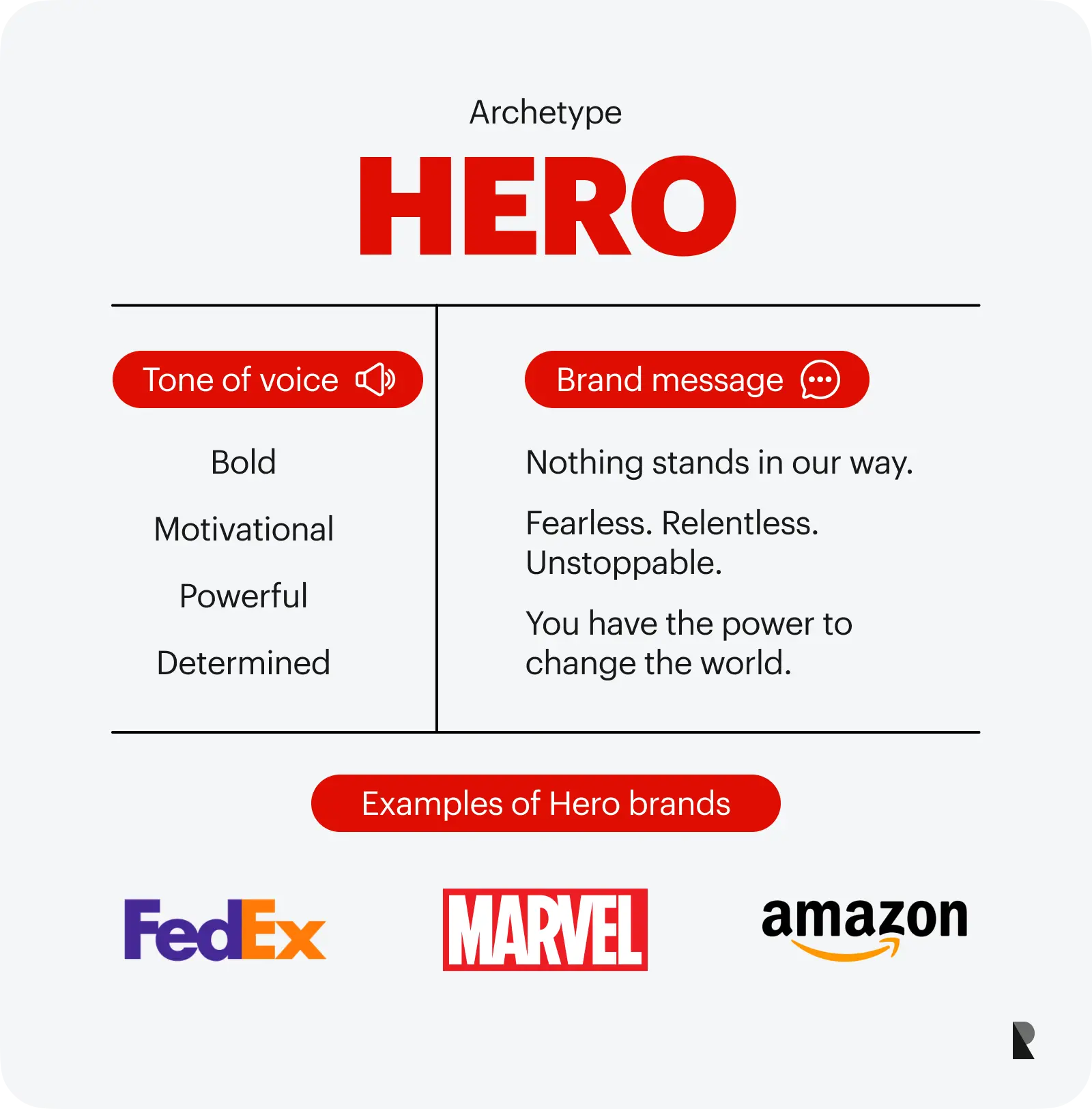
The Hero brand archetype
9. Everyman
Everyman is also known as a regular person. It does not like to stand out from the crowd or be a hero. It prioritizes a simple, regular life. Driven by a core desire to belong to a community, it favors generalized approaches that easily relate to all people because of familiarity, unpretentiousness, friendliness, and simplicity.
This type revolves around everyday activity and seeks down-to-earth ways to become an integral part of society. It offers affordable products and services that are part of daily routine.
Everyman's key traits are being realistic, pragmatic, approachable, and friendly.
The most notable examples are Ikea and Gap.
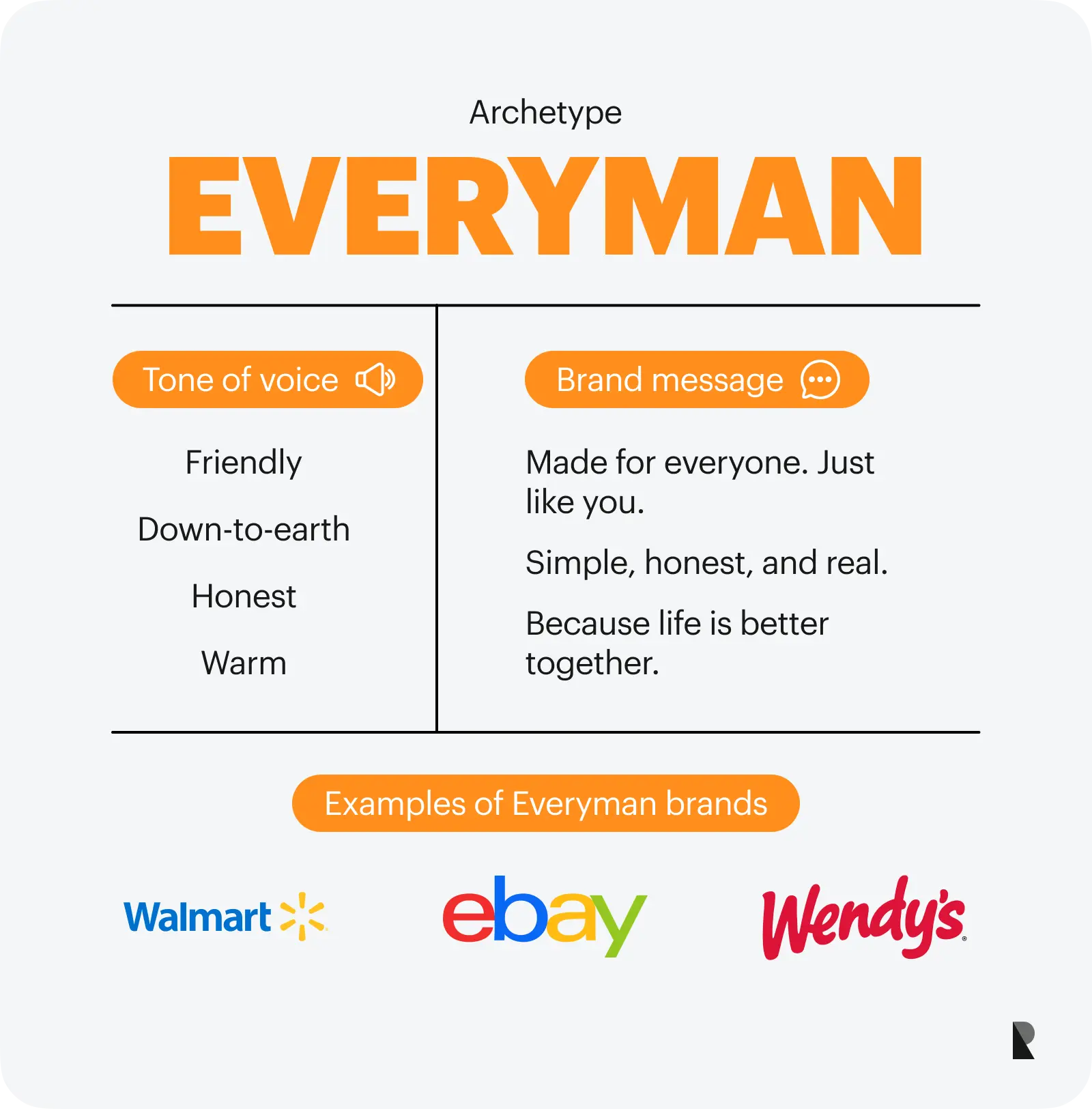
The Everyman brand archetype
10. Rebel
The rebel brand archetype resists control, tradition, and existing paradigms. It is a loner with strong leadership abilities who puts maximum effort into achieving their goals. Often idealistic and perfectionist, it does not take "no" as an answer, finding alternative ways to get what it wants. It also values freedom of choice, self-realization, and expression.
This type challenges conformity, rules, and everyday habits. It is not everyone's cup of tea. Only a small, close-knit audience may appreciate its potential and benefits.
The key traits of the Rebel or Outlaw are Rebellious, Confrontational, Combative, and Independent.
The most notable examples are Harley-Davidson and Diesel.
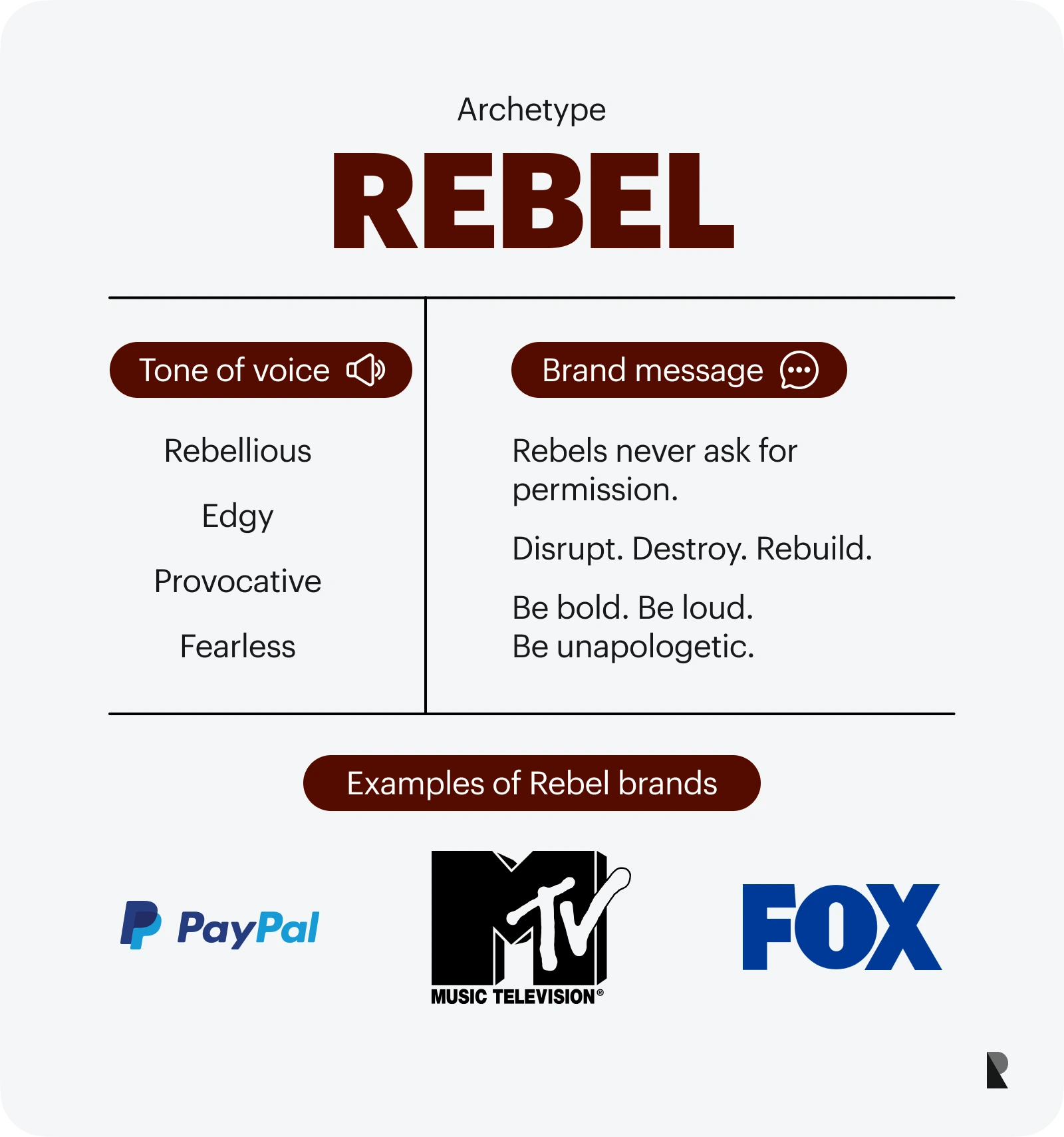
The Rebel brand archetype
11. Explorer
Explorers are closely related to pioneers, travelers, and discoverers. This brand archetype will take you on the adventure of a lifetime. Freedom, independence, and a desire to break out from the comfort zone make it stand out from the crowd and win over people across the Globe. It can be daring yet caring. It is bold, brave, and laughs in the face of challenges and problems.
This type promotes adventure and discovery through exploring outdoor and uncharted territories.
The key traits of the Explorer are Discovery, Exploration, Bravery, and Pioneering.
The most notable examples are the Jeep and the NASA.
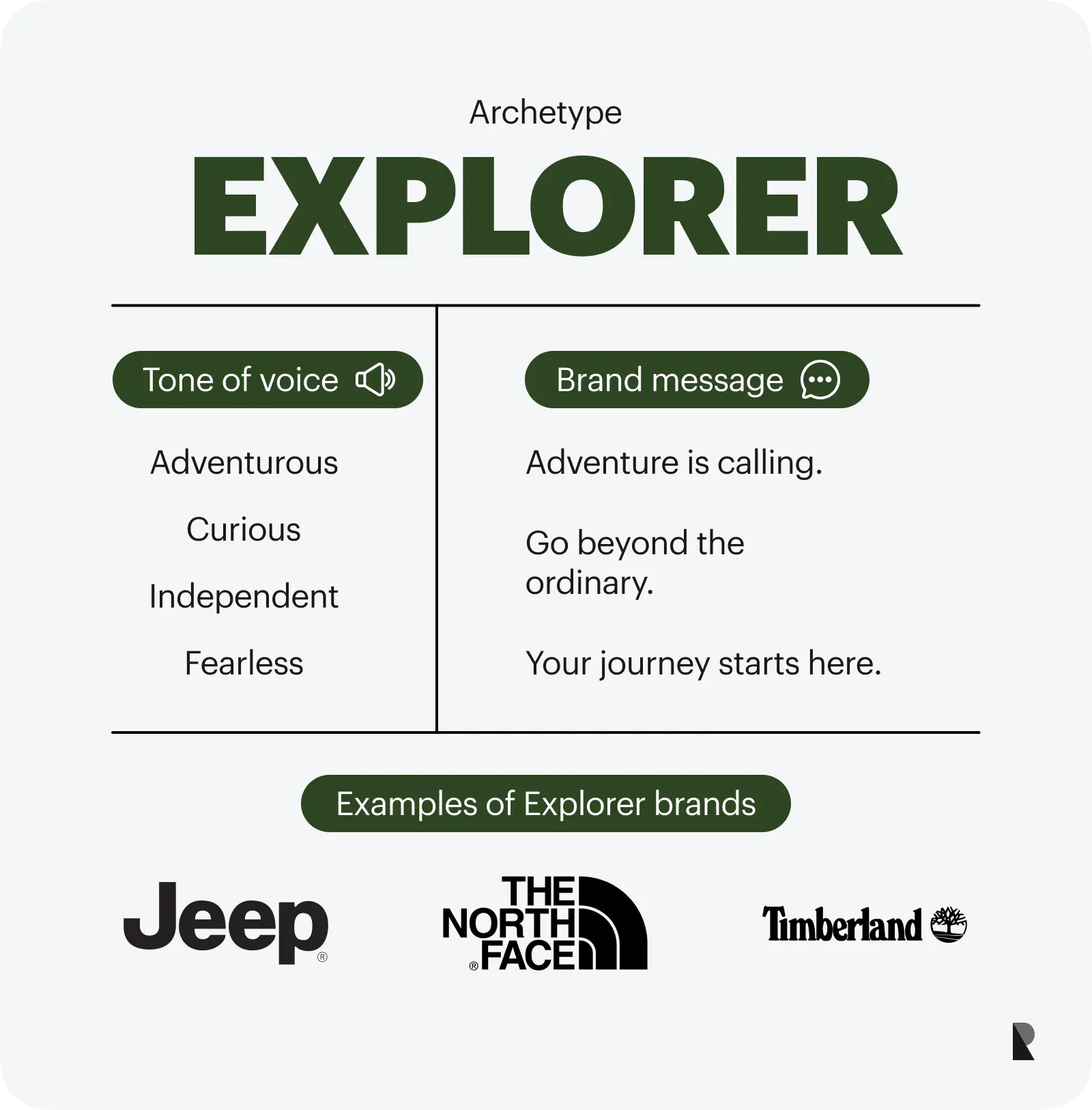
The Explorer brand archetype
12. Lover
The lover is an affectionate and empathetic brand archetype that is sensual and passionate about a cause or people. It inspires close connection through romance and seductiveness.
The lover uses emotions and feelings to build spiritual, familial, or companionable relationships. It aims to increase its appeal and attractiveness to be more desirable.
This type makes people feel loved and desired. It offers products that help build close and emotional relationships and express inner love. It stirs customers' passionate desires for sensual pleasure.
The key traits of the Lover are Passion, Empathy, Romance, and Soothing. The most notable examples are Alfa Romeo and Tiffany.
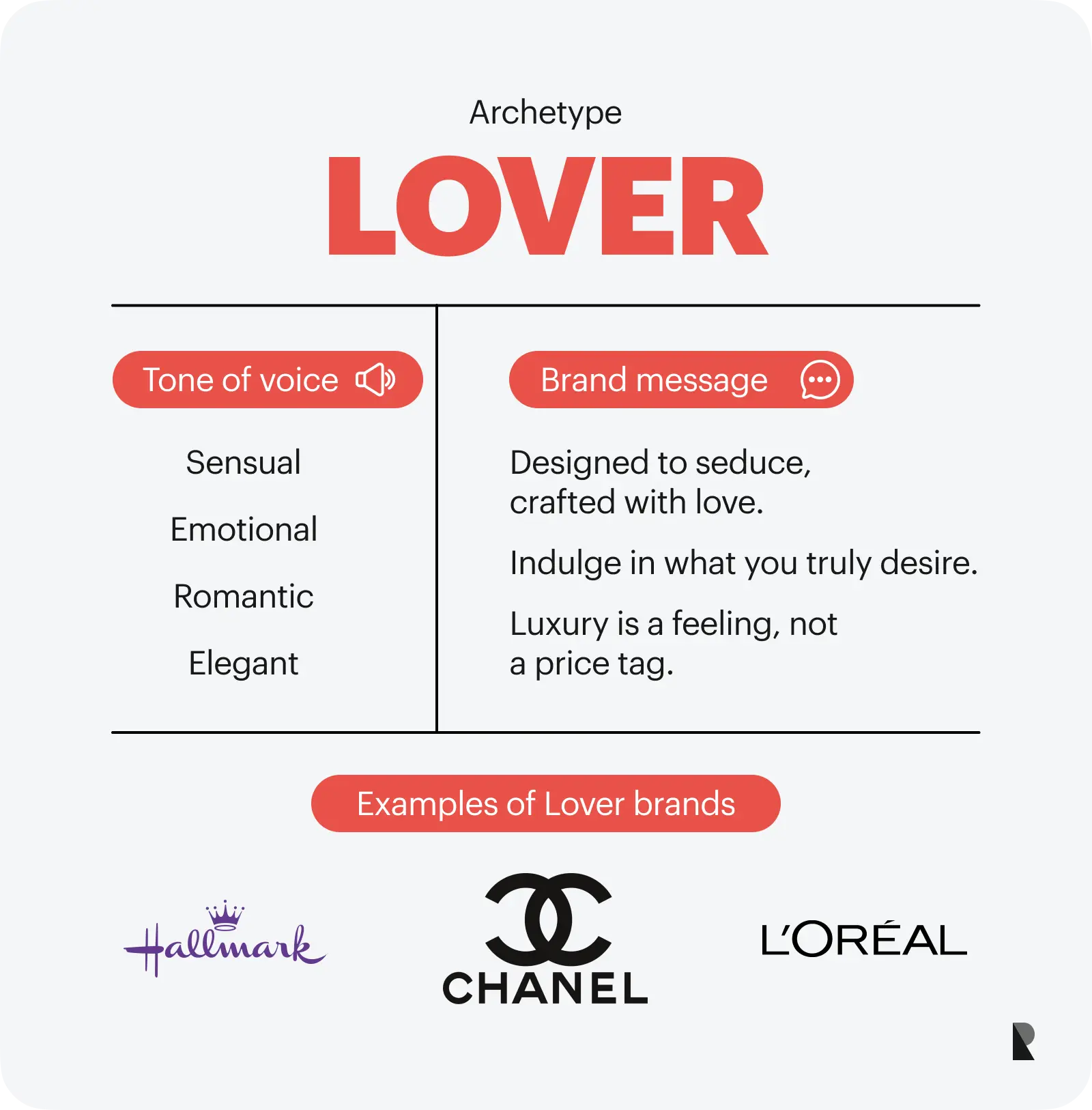
The Lover brand archetype
Define Your Brand Archetype
With 12 available brand archetypes, it can be difficult to understand which is most related to your company. Some have similar characteristics, while others may lack some of your traits. So, what should you choose?
Follow these five steps to determine the correct brand archetype for your company and unlock the power hidden inside this phenomenon.
Step 1 – Dive into your brand's essence
Defining the right brand archetype starts with thoroughly understanding who you are and what you stand for. You need to inspect the core of your brand identity.
Examine the brand's vision, value, mission, unique selling proposition, positioning, personality, and philosophy.
Step 2 – Get to know your target audience
After determining your company's personality, charisma, and unique traits, it is crucial to analyze your target audience. This knowledge helps you select an archetype that aligns with your brand identity and resonates with the prospects.
Conduct market research and surveys to gather as much information as possible. You must understand your ideal customer's preferences, needs, problems, expectations, values, and behavior patterns.
Step 3 – Get emotions correct
The correctly defined brand archetype makes sense psychologically and strategically. It tugs customer's hearts, leaves long-lasting impressions, and emerges during the sales cycle, giving some strong arguments to choose your company or product over others. It stands behind the emotional bond that underlies strong relationships and loyalty.
Therefore, make clear what feelings and emotional responses you want your brand to evoke in your target audience. Ask yourself, how should it be perceived emotionally, and where should it get your customers after an interaction?
Step 4 – Understand brand archetypes.
Once you fully understand who you are, carefully examine brand archetypes. There are 12 of them. Some of them may look alike at first. To avoid confusion and make the right decision, examine each one thoroughly. Get answers to these questions:
- What brand archetype fits your company the most?
- Can and how it might work to connect your company and target audience?
- Does it fit your future goals?
Step 5 – Do a final assessment.
Whether you doubt the chosen option or have complete confidence in it, doing some final assessment through A/B testing or surveys is always better.
Before looking for ways to support your brand type and running expensive marketing and advertising campaigns, you must first ensure that everyone is on the same page and that customers perceive you as you want them to.
Gathering as much feedback and opinions as possible through surveys and polls in digital media, particularly on social media, is the best way to assess the correctness of your choice. It will give insight and much-needed information to choose the right option.
The Smooth Intersection of Brand and Archetype
Defining the right archetype is just half the battle. It must be correctly applied and integrated into every aspect of its existence and presence to ensure it yields "fruits" and assists the company's growth and success in the market. Consider these three crucial tips to intersect brand and archetype smoothly.
Choose what the audience is interested in
Customer's needs and preferences constantly change. Even though they may stay within their archetype, they still vary.
Understanding what the audience is interested in right now is crucial. This information helps you run accurate, high quality campaigns, bring true value to your customers, and evoke necessary emotions.
Add the right emotion
People are emotional creatures, and they may be affected by external factors. Your task is to catch their drift and understand what bothers them the most. This helps to deepen your brand's connection with them and stay authentic in communication and interaction.
When creating marketing campaigns, focus on the audience's emotional state. Analyze external factors and do some research. It would help to run a survey and determine customers' behavior patterns in controversial situations.
Use this knowledge to adjust the emotional constituent of the campaign and brand strategy accordingly.
Three Notable Examples of Brand Archetypes
1. Nike
Nike is the brightest example of the Hero archetype. Its products and advertising campaigns scream the power of self-belief and transformation. It helps its customers unlock their true potential and overcome all challenges, inspiring achievement and self-improvement.
2. McCain
McCain and "We Are Family" exemplify the Everyman brand archetype. Its non-pretentious, simple, and comfortable approach to connecting with clients and promoting its products makes it easily relatable to people across a wide market and multiple cultures.
3. Netflix
Netflix shows us what the real Jester brand archetype should look like. It encourages its target audience to live in the moment and enjoy its endless shows and movies. It is like a ray of sunshine that fills every day with a positive experience.
Conclusion
Building a brand becomes a challenge with so much noise in the market. As practice shows, you will succeed only if you build loyalty and cultivate affection for your brand. And there is no better way to do this than to connect with your audience personally and emotionally, using your brand archetype.
As a method of presenting the company, it gives the business a much-needed depth of personality, humanizes connection and interaction with the customers, and creates a strong emotional bond. There are 12 archetypes, so you will find the one that best describes you and resonates with your audience the most.
Mar 27, 2024
